2018 Achievement Award Nominations & Recipients
The North American Lake Management Society, NALMS, recognizes individuals, teams, and organizations for their efforts and contributions to enhance management of lakes and reservoirs. Each year NALMS receives nomination letters from members and supporters lifting up their peers – individuals and groups – worthy of receiving recognition for their dedication to NALMS’ mission and/or for strides made in leadership, education, and lake management. It is with great honor that we share these nomination letters, as well as the 2018 award recipients recognized at the NALMS 38th annual symposium in Cincinnati, Ohio.
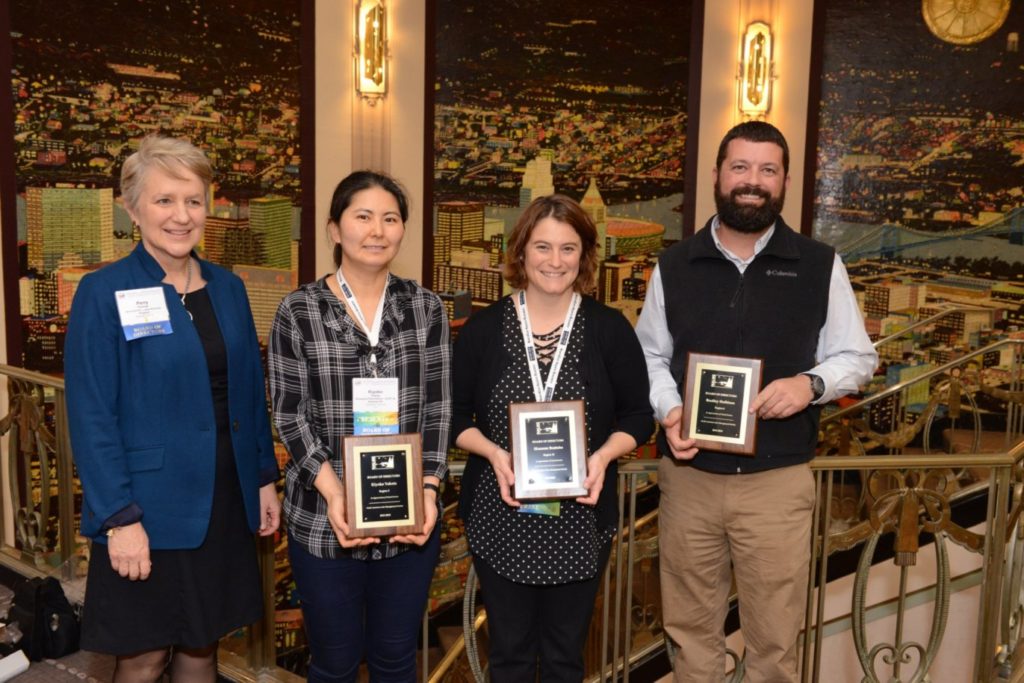
Outgoing Officers & Directors
NALMS is a product of devoted individuals volunteering their time and efforts as officers and directors to advance the NALMS’ mission. Thank you outgoing officer and directors!
Officers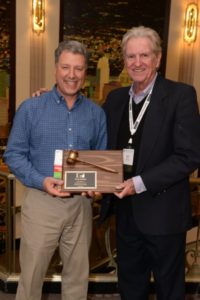
- Frank Wilhelm, Past President
Directors
- Perry Thomas, Region 1
- Kiyoko Yokota, Region 2
- Brad Hufhines, Region 6
- Shannon Brattebo, Region 10
- John-Mark Davies, Region 12
Leadership & Service Awards:
Education & Outreach
Awards individuals or teams for design, facilitation, or performance of exceptional education and outreach activities supporting community understanding and appreciation of lake and reservoir management. Congratulations to our 2018 recipients!
Clear Lake Township Land Conservancy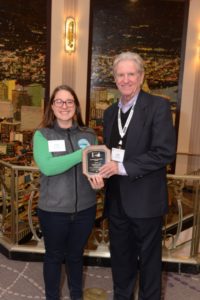
Nominated by Kathy Schenkel
The Clear Lake Township Land Conservancy (CLTLC) is a small, innovative 501(c)(3) land trust in northeast Indiana formed in 1991 “to preserve, protect, and manage the natural environment within the watershed and township for future generations”. CLTLC has an executive director and operates through a volunteer board and community volunteers. It protects nearly 65 acres in the watershed surrounding the 800-acre, appropriately-named Clear Lake.
Two programs stand out in Education and Community Outreach—Knee-high Naturalists and “ASK BRIDGET”.
The Knee-high Naturalists program began in 2006 as a volunteer program to introduce youngsters to a variety of nature topics in four Friday programs each July. Attendance for the 1-1/2 hour programs averages about 20-30 over the month. The programs are organized by CLTLC’s Education Committee and feature hands-on interactive sessions led by local experts.
In 2018, the programs covered Gone Fishin’, a farm tour on a Township farm, Buzzing Bees, and Animal Tracks and Scat. Each program features a part of the environment (heavy focus on animals, fish, plants) and relates the importance of clean water for the survival and growth of these life forms. Prior years covered topics related to the Lake environment such as birds/raptors, art in nature, water testing and worm composting.
The Knee-high Naturalists programs make early and lasting connections for our future generations to the beautiful Clear Lake environment we value and protect. As the grandmother of 3 participants, I can personally vouch for the excitement and discussion these programs generate among Clear Lake’s young people. I applaud the Knee-high Naturalists programs as an exemplary way to engage future generations.
The CLTLC serves both kids and adults! The “ASK BRIDGET” concept is an adult education program launched in 2018. As Clear Lake summer residents returned after the long winter and rainy spring, neighborhood conversations often turned to why the normally “pristine blue” Lake was “murky brown” in the spring of 2018. CLTLC Board members and staff began hearing a “buzz” of community conversation, often blaming farm run-off or land clearing. CLTLC looked for a way to address the question quickly, factually and concisely across the community, rather than one person at a time.
When most of us at Clear Lake have or hear questions about the environment, we speculate a bit and then say “Ask Bridget”. Why? Because Executive Director Bridget Harrison is the most visible and credible source of environmental information in the Lake community! However, Bridget is the only staff member, so she and the Board looked for a way to provide short, timely information to the entire community on a “hot issue” rather than responding individually to each call and email.
Tapping into the communication channels used most in the community, the first “ASK BRIDGET” was written and posted to the CLTLC website and linked to its Facebook page, on NextDoor, and on the Clear Lake Bulletin Board. The blogpost is “branded” with the Conservancy logo, Bridget’s name and her widely recognized orange Prius! No surprise—the answer centered on turbidity resulting from heavier than usual spring rains. We knew it was a successful communication method when the word “turbidity” cropped up often at family and friend gatherings!
Holly Hudson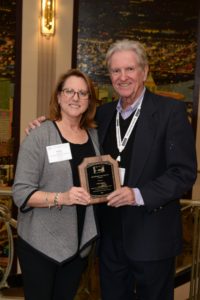
Nominated by Jeff Boeckler, Northwater Consulting
Holly Hudson is being nominated for her many years educating individuals and communities in Illinois on lake and reservoir management. Over the years, Holly has dedicated herself to volunteer initiatives, outreach and education programs, and lake watershed management. Highlights of her work demonstrating a high level of involvement, measurable impacts, sustainability of action(s), and innovation in lake and reservoir management include:
- Illinois Volunteer Lake Management Program (VLMP) coordinator in northeastern Illinois for over 30 years, including development of the program, training manual, and video. It is estimated that Holly has worked with or trained over three thousand volunteers; many have remained in the VLMP throughout her entire career. Holly spends considerable time with her volunteers, performs QA/QC, generates annual reports, and addresses problems when they occur.
- Holly has been a leader in lake monitoring and management activities in northeastern Illinois. Between 1988 and 1992, the Illinois Environmental Protection Agency (IEPA) awarded three Section 314 Federal Clean Lakes Program Lake Water Quality Assessment grants. The purpose of these grants was to improve the quantity and quality of lake information available to meet Section 305(b) reporting requirements. To assist the IEPA in meeting these requirements, Holly provided program coordination in the six-county northeastern Illinois region and conducted water quality and sediment sampling and analysis. A total of 103 new lakes were sampled and analyzed as a result of her efforts. Under Section 314 Federal Clean Lakes Program and Illinois Clean Lakes Program, Holly acted as the primary investigator for Phase I Diagnostic/Feasibility studies of 12 northern Illinois lakes. The reports completed for these studies provided lake communities with a “road map” for improvement activities.
- Holly has worked with many communities to develop lake watershed plans, combining stakeholder education and outreach with the analysis necessary to identify practices that positively impact water quality. A personal statement from Tim Loftus, a past colleague of Holly’s, is attached.
- Holly has written a number of “Lake Notes” fact sheets. Lake Notes is a series of publications produced by the IEPA about issues confronting Illinois’ lake resources. The objective of these publications is to provide lake and watershed residents with a greater understanding of environmental cause-and-effect relationships, and actions that can be taken to protect our lakes. These Lake Notes touch on a number of the NALMS goals below and are still widely distributed today. (http://www.epa.illinois.gov/topics/water-quality/surface-water/lake-notes/index)
- For many years, Holly helped implement Illinois’ Clean Water Act 208 Program as her agency is one of three Illinois designated area wide water quality management entities. Through this role Holly evaluated lakes and streams and provided input on Waste Water Treatment Plant siting.
Michigan Shoreline Stewards Program
Nominated by Jo Latimore, Michigan State University
Michigan has over 11,000 inland lakes greater than 5 acres. Studies show that while overall Michigan’s inland lakes are fairly healthy the number one stressor is poor lakeshore habitat. The 2017 National Lake Assessment indicated that 50% of Michigan’s inland lakes have poor lake habitat complexity with only 20% having problems with nutrients. The Michigan Natural Shoreline Partnership www.mishorelinepartnership.org developed the MI Shoreland Stewards Program as part of their homeowner outreach component. This program is a multi-faceted approach to engaging and empowering lake property owners to protect and restore their lakefront property.
The main component of the Michigan Shoreland Stewards (MiSS) Program is the voluntary web-based survey. This survey asks property owners about their management practices on their entire property. The property is broken down into four main areas: the upland, the buffer, the shoreline and the lake. Participants are also provided with information along the way to help them better understand the question and how it impacts the lake. Individual properties can potentially qualify for three different levels: Gold, Silver and Bronze. If a property does not yet meet the standards for these levels, a starter level will be indicated. Every property is different. Some properties will qualify right away, some will need improvements, while others may not be qualify. If a property does not meet the standards to qualify as a Shoreland Steward, the property owner will be provided with general suggestions for improvement. They are then encouraged to take the survey again once they’ve implemented changes to their practices. Certificates are provided for registered participants and all participants have the option of purchasing a sign for their property (see attached results after two years).
The MI Shoreland Stewards Program can also be utilized by lake groups to help promote healthy lake front property management and provide special recognition to their property owners by registering their lake group on the website. An icon will appear on the MiSS website for their lake group, they can access promotional materials and see the results of surveys from their lake. They can also use this in conjunction with a whole lake shoreline assessment to track the status of their lake’s shoreline over time. These programs have created local interest regarding inland lakeshore protection and more outreach is needed to increase the local knowledge base and strengthen local volunteer efforts.
In addition, the MI Shoreland Stewards Ambassador Training is being developed. This training program is intended to provide resource materials and assist lake association members in being more effective in promoting the MiSS with property owners, answer questions about the program and survey and direct people to the correct resources. Resource materials include toolkit for getting started, online powerpoint presentations to review for a “how to”, short videos to provide information on each of the four different “shoreland zones” identified in the MSSP and promotional materials to use.
Leadership & Service Awards:
Volunteer
Friends of Deep Creek Lake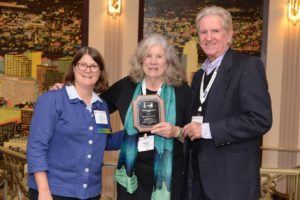
Nominated by Lisa Borre
The Friends of Deep Creek Lake was founded in 2008 by Barbara Beeler after she observed a bright neon green (Euglena) scum covering the lake as far as the eye could see. She talked with neighbors about her observations, and together they created the Friends of Deep Creek Lake as a watershed organization. Within a couple years of its founding, the organization had already involved hundreds of volunteers in lake monitoring projects. Every spring FoDCL volunteers kicked off the summer season with water quality monitoring in the many streams flowing into the lake. Over 100 sites have been sampled in the past decade. Friends of DCL volunteers also undertook stream sampling as a part of development of baseline data in case of hydraulic fracking were to occur in the watershed.
Additional small grants led to a year-round sampling of two streams as well as two years mapping and sampling the many culverts channeling runoff into the lake. Working with Maryland DNR staff, Beelar designed and implemented the Off Your Dock sampling in 12 lake coves to measure suspended sediment and changes caused by boating activity. Over the past decade, FoDCL has secured a number of grants to expand data collection as well as compilation of all data sets on the lake and watershed. At the same time, the organization began to organize lake stakeholder concerns by circulating petitions to policy makers, first with the Lake Manager, then the Policy and Review Board, and eventually to the Secretary of DNR and the Governor.
At the core of the FoDCL effort has been community education for lake stakeholders and policy makers on dynamics of lake and watershed challenges. These efforts have made major contribution to understanding of the condition of the lake and watershed, the dynamics of lake aging, and best management practices for restoration and remediation from other lakes.
In recent years, FoDCL has become an advocate in the Maryland legislature for the state-owned lake. In 2013, FoDCL advocated for the Governor to declare July as Lake Appreciation Month, and this has become annual tradition acknowledging the importance of lakes in a Bay-centric state. FoDCL introduced a bill to prevent further introduction of aquatic invasive species into the lake. Recently the legislative efforts have focused on securing funding for lake protection and restoration efforts. In 2018, due to the tremendous effort by FoDCL volunteers and funds they raised to hire a lobbyist, the Governor signed into law a State Lake Restoration Bill that appropriates $4 million in funding over the next four years.
FoDCL sees the primary challenge today is securing sustained funding to underwrite sediment removal and remediation for 10 sediment impaired coves, installation of a cleaning station to prevent further introduction of aquatic invasive species into the lake, as well as a range of initiatives in the watershed such as tributary stabilization, and runoff prevention. Of late, the impacts of climate change are of increasing concern to FoDCL volunteers with a less clear path on how to provide protection as needed.
Beelar and the Friends of DCL have demonstrated a firm commitment to community education and outreach enhanced by a persistence, which comes from the deep personal commitment FoDCL members have for Deep Creek Lake. In 2016, FoDCL received a Citation from the Governor acknowledging its efforts and importance in protecting Deep Creek Lake.
Stephen McCord
Nominated by Priya Ganguli, California State University
It is an honor to recommend Dr. Stephen McCord for the NALMS Volunteer Leadership and Service Award. I am a new Assistant Professor, and unexpectedly stepped into the role of President-Elect for the California Lake Management Society (CALMS). While this has been an exciting experience, it has also been overwhelming at times, and I often rely on Dr. McCord for input and advice. Throughout the last year, Dr. McCord has dedicated a substantial amount of time supporting CALMS, despite the fact he is no longer a CALMS officer. In addition to helping me with involved tasks, such as setting up contracts with outside vendors, he participates in CALMS conference calls and is one of the most frequently sought out members for input on major administrative decisions. All of this effort is on a volunteer basis, and obviously stems from Dr. McCord’s dedication to advancing our understanding of lacustrine systems, as well as his commitment to supporting the next generation of scientists and environmental managers. Given his ties to academia and to the public and private sectors, Dr. McCord is uniquely poised to bridge science, policy, and technological innovation. The considerable amount of time and energy he freely gives to the greater lake management community makes Dr. McCord incredibly deserving of the NALMS Volunteer Leadership and Service Award.
Advancements in Lake Management Techniques
William (Bill) James
Nominated by Joe Bischoff
Bill James has been researching lake management techniques for almost 40 years and has contributed significant advancements in the application of aluminum sulfate (alum) to lakes to control sediment phosphorus release. Bill is a longtime Associate Editor for Lake and Reservoir Management and an active participant in NALMS, advancing the mission of NALMS and encouraging students to become active members.
Bill’s work focuses on advancing our understanding of alum doses and aluminum binding efficiency to ensure that alum treatments result in long term improvements in water clarity. While Bill has been researching sediment phosphorus release and alum treatments for many years, in 2011 he published a paper on Half Moon lake that identified variable binding efficiency of aluminum to phosphorus using lab assays (James 2011). This paper was awarded the NALMS best paper award. Bill continued to explore this concept using a number of lakes in Minnesota and Wisconsin, determining that the binding efficiency was, in fact, predictable and could be used to develop alum doses that maintain cost efficiency while improving long term performance (James and Bischoff 2015). One of the primary lakes in this study was an alum application on Bald Eagle Lake which won the Minnesota Association of Watershed Districts’ Project of the Year Award in 2016. Bill was an integral part of the team that completed the alum treatment on Bald Eagle Lake. Bill continues to advance and confirm these concepts and recently discovered that alum floc often sits on the sediment surface in lakes with dense sediments which influences the sediment depth that can be expected to be inactivated by the alum treatment (James 2017). Bill is also exploring phosphorus equilibrium dynamics in suspended sediment that might affect alum doses and effectiveness.
Overall, Bill’s research over the past decade has contributed significantly to our understanding of alum treatments in lakes, improving the effectiveness and longevity of the lake management technique. His contributions to our understanding of how to determine alum doses has saved lake managers significant amounts of many and given them the confidence that the alum treatment will be effective. These contributions are leading to more alum treatments that result in long term success and are improving lakes throughout the world.
Lake Management Success Stories
Awarded to individuals or organizations accomplishing successful lake management efforts. Nominees must show demonstrable improvements in lake conditions through lake and watershed management.
Columbia Association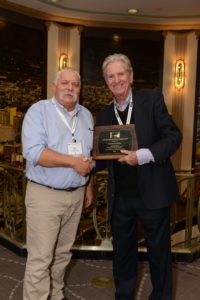
Nominated by Lisa Borre
Columbia Association (CA) is a nonprofit community services corporation that manages Columbia, Maryland, a planned community that is home to approximately 100,000 people and several thousand businesses. CA maintains more than 3,600 acres of Columbia’s open space. This includes more than 114 miles of pathways and sidewalks for walking, biking and jogging. It also includes an extensive network of pedestrian underpasses and overpasses, meadows, forestland, basketball courts, public tennis courts, and village center plazas located throughout the community. There are 183 storm-water structures of various types on CA property. Of the 183 storm-water structures, there are 45 wet ponds and the three lakes that drain to the Little and Middle Patuxent Rivers. CA and its partners believe that small-scale residential storm-water management practices need to be implemented on a large scale and in conjunction with activities that reduce nutrient usage to reduce the flow of storm-water, nutrients, and sediment from developed land to the Chesapeake Bay.
The Columbia Association (CA), working in concert with Howard County Government and the State of Maryland, has been investing in Best Management Practices (BMPs) designed to improve water quality and habitat in the Middle and Little Patuxent watershed since 2009. The Columbia Watershed management plan was finalized in 2009, and a watershed manager was hired shortly thereafter. The watershed manager has since overseen numerous projects ranging from individual residential rain gardens, to multi-million dollar capital projects to restore the function of CA’s three lakes. CA leverages grant funding where possible, and has collaborated with the Maryland Department of Natural Resources to fund a residential rain garden program that has installed over 350 gardens to date and engaged thousands of residents about storm-water management. In the past year, CA has received $542,000 in reimbursements from the state of Maryland for watershed restoration projects. Since 2012, CA has been reimbursed 2.3 million dollars for various watershed improvement projects, including multiple bioretention facilities and stream restoration projects.
CA is responsible for the management of the aesthetic and structural aspects of the three lakes and 45 smaller ponds. The management of these lakes and ponds includes the periodic removal of sediment. CA recently created a sediment placement site, which is estimated to save 2 million dollars over the next 20 years. Activities to reduce the sediment load to CA’s lakes have been ongoing. Thirty bioretention facilities are installed on CA property, of which 19 were installed voluntarily to reduce runoff volume.
Community outreach has been integrated into CA’s watershed management efforts. Since 2012, over 3000 trees have been planted in CA’s open space as part of an ongoing reforestation effort. The “Test your lawn” soil test program has provided over 750 free soil tests to residents in an effort to reduce excess fertilizer and nutrient inputs. Water chemistry is regularly tested to measure the health of CA’s watershed. CA is interested in maintaining the ecological and structural health of storm-water features in Open Space, and works together with local residents, Howard County, the State of Maryland, and other organizations to accomplish these goals.
Deal Lake Commission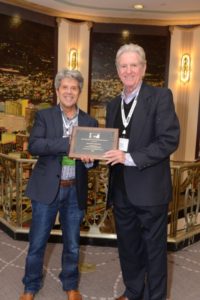
Nominated by Stephen Souza
Chartered in 1974, the Deal Lake Commission (DLC), the State’s appointed steward of Deal Lake, has overseen the management and restoration of Deal Lake and its watershed. Consisting of appointees from the seven municipalities abutting the lake, the DLC’s mission is to provide leadership, guidance and resources to preserve and restore Deal Lake and its tributaries as a healthy and stable ecosystem. The Commission is proud of its accomplishments which include:
- Educating the community, including school children, to increase awareness and appreciation for the natural environment of the lake
- Sponsoring and conducting public engaged spring and fall cleanups, which annually result in the removal of 1,000s of pounds of refuse and debris from the lake
- Helping homeowners and public groups recognize and mindfully solve problems related to water quality, siltation, and lake restoration
- Serving as the liaison between lakeside communities, County agencies, and the NJDEP
- Actively working with NJDEP to develop the Deal Lake TMDL and Lake and Watershed Management Plan
- Microbial source tracking investigations with Monmouth University and pathogen source identification work with Clean Ocean Action to decrease E. coli loading
- Implementing a series of watershed management projects as part of the DLC authored Regional Storm Water Management Plan to decrease nutrient, sediment and pathogen loading
- Implementing a number of NJDEP, Army COE, and 319 funded innovative green infrastructure, soil stabilization, and restorative dredging projects
- Carp removal, invasive species management, and goose control initiatives
- Participating in the HAB research efforts of Monmouth University
- Working with State legislators to implement stricter stormwater controls to reduce pollutant loading, increase storm resiliency, and improve recreational fishing
- Participating in the NALMS Secchi Dip In
- Proactively suggesting and supporting community-based, practical ideas to improve the overall environmental quality of the lake and its enjoyment by boaters, anglers, hikers, residents and visitors
The DLC is especially proud of its efforts and accomplishments in managing the runoff from the lake’s watershed. The 162 acre lake, the largest coastal lake in New Jersey, is surrounded by a 4,400 acre highly urbanized watershed. The vast majority of the watershed was developed between the late-1800s and mid-1900s. Additionally, practically all of the lake’s 27 mile shoreline is developed. Due to the history, intensity and age of land development, very little infrastructure exists to actively manage and treat stormwater before it is discharged into the lake. And because of the extent and nature of this development little opportunity exists to construct conventional surface basins. However, even though this presents a number of challenges, these challenges have been embraced by the DLC and they have worked diligently over the years to correct these issues. Their efforts are best reflected in a recently completed 319 funded project that resulted in the construction of bio-infiltration basins, installation of structural BMPs and re-vegetation of shorelines that help reduce pollutant loading to the lake. Recognizing the success of the DLC’s efforts over the past three decades, the NJDEP recently awarded the DLC with an additional $750,000 to implement more green infrastructure BMPs and install floating wetland islands.
Deep Creek Lake POA & partners
Nominated by Lisa Borre
For this submission, the Property Owners’ Association of Deep Creek Lake (POA) is considered the lead organization but it has no control over any other organizations mentioned. The other organizations that are at times part of the partnership are The Deep Creek Watershed Foundation (DCWF), Brookfield Renewable Power, Department of Natural Resources (DNR), Maryland Department of the Environment (MDE), and Garrett County Government.
In the 2012-2014 timeframe, a group of State, County, and Local individuals were brought together to create a Watershed Management Plan (WMP) for the Deep Creek Watershed. The watershed is 41,000 acres; the lake is 3,900 acres. Deep Creek Lake (DCL) is manmade and the largest lake in the State. It has evolved as a major tourist destination and is the economic engine for Garrett County.
The WMP is composed of 13 goals with many objectives and strategies leading to accomplishment of the goal. The implementation of the WMP has begun but will take years to address all that needs to be done.
In an effort to attract private donations and create private-public partnerships focused on further implementation of the WMP, the DCWF was created and already has supported the WMP in several ways through independent and partnering opportunities.
Rice Creek Watershed District & Wenck Associates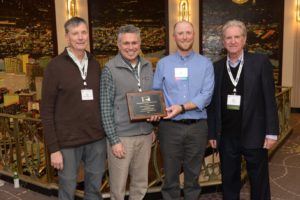
Nominated by Gary Krejcarek
The Bald Eagle Restoration Project represents the successful implementation of a high priority project through the collaboration of multiple entities led by the Rice Creek Watershed District (RCWD) and Wenck Associates, Inc. (Wenck). The path to success for this project required strong stakeholder support, a dedicated project sponsor (RCWD), and innovative technical leadership to reach aggressive restoration goals (Wenck). Years of hard work and dedication culminated in one of the premiere lake restoration success stories in the Minnesota and was highlighted in the Winter 2017 LakeLine issue focused on restoration success stories.
In 2002 Bald Eagle Lake was included on Minnesota’s impaired waters list since the lake did not meet state standards for nutrients, algae, or clarity. In fact, summer averages for phosphorus and algae were typically 3X higher than state standards. Algae blooms inhibited recreational use, negatively impacting the fishery and native plant community. Residents and those who used the lake for recreation commonly perceived it as “unclean”. The RCWD and Wenck developed a series of diagnostic studies and implementation plans to restore Bald Eagle Lake including a Total Maximum Daily Load and an internal phosphorus release study.
Utilizing an innovative mix of funding sources, including a Clean Water Fund grant, Clean Water Partnership loan, and locally-petitioned special tax district, the RCWD and Wenck Associates, Inc. completed three major projects to improve the lake. First, RCWD utilized its existing Water Quality Cost-Share program to target untreated residential stormwater runoff and eroding shorelines. Working with landowners, the RCWD constructed ten residential raingardens and six shoreline restoration projects. Next, RCWD acquired a Clean Water Fund grant to complete a stormwater reuse project, with additional funding from the City of Hugo and the Oneka Ridge Golf Course. This unique public-private partnership decreased nutrient loading to Bald Eagle Lake, as stormwater was reused for golf course irrigation and infiltration. Finally, RCWD and Wenck completed Minnesota’s largest aluminum sulfate treatment on the lake. Wenck and the RCWD thoroughly evaluated different options for internal nutrient load reduction based on cost, timeline, and overall effectiveness. An in-lake alum treatment was identified as the most effective option. However, with a price tag nearing 1 million dollars, funding was a barrier. In a strong show of their desire to improve water clarity, the Bald Eagle Area Association (BEAA) petitioned the RCWD to form a Water Management District (WMD), a special tax district for lake residents. Funds collected by the WMD would pay for approximately half of the alum treatment, with funds collected slowly over a period of 12 years. RCWD obtained a Clean Water Partnership loan from the Minnesota Pollution Control Agency to provide up-front funding for the 12-year WMD proceeds. RCWD paid for the other half of the alum treatment.
As a result of the strong leadership from the RCWD and technical excellence from Wenck, algae blooms are now non-existent in Bald Eagle Lake, and the lake is meeting state water quality standards for the first time since water monitoring began in 1980. Phosphorus was reduced by 55%, algae was reduced by 65%, and water clarity improved by 60%. The more stringent RCWD nutrient targets were met, along with the lake association’s overall clarity goals.
Friends of NALMS Award
Awarded to individuals or corporations making major contributions to NALMS. Recipients do not need to be NALMS members and contributions extend beyond monetary donations.
Robert (Bob) Carlson
Nominated by Lisa Borre and Nancy Mueller
As the co-founder of the Secchi Dip-In program and leader of volunteer lake monitoring efforts for more than 40 years, Dr. Bob Carlson has made significant contributions to NALMS. Dr. Carlson is now a Professional Emeritus member of NALMS and continues to advise on the implementation of the Secchi Dip-In since the program was transferred to NALMS management in 2015. Now in its 25th year, the Secchi Dip-In has proven to be one of the most successful volunteer water monitoring programs in North America.
The first Secchi Dip-In began as a pilot study in 1994 conducted by Drs. Robert Carlson, Dave Waller and Jay Lee from Kent State University. During Dip-In ’94, over 800 volunteers from six Midwest states (Indiana, Illinois, Michigan, Minnesota, Ohio, and Wisconsin) participated. The results from the first Dip-In suggested that regional patterns in transparency did exist, appearing to correlate with land use and whether the water body was a natural lake or a reservoir.
When the first Secchi Dip-In was proposed in 1994, it was hoped that the project would make it past one or two years. Thanks to the support of volunteer programs and volunteers, the North American Lake Management Society (NALMS), and the Environmental Protection Agency (EPA), the Dip-In database has grown to more than 41,000 records on more than 7,000 separate waterbodies, not including different sites, such as along rivers and estuaries.
In 2015, after leading the Secchi Dip-In for 20 years, Dr. Carlson and NALMS entered a long-term agreement transferring the operations of the Dip-In to NALMS. Through a partnership between NALMS and EPA, the historical Secchi Dip-In database (1994-2014) has now been uploaded to EPA’s Storet database and is publicly available in the Water Quality Portal (WQP).
Dr. Carlson and his students have conducted research ranging from the trophic state classification of lakes and reservoirs to using paleolimnological techniques to investigate the effect of past fish species introductions to lakes. He has been involved with volunteer monitoring since 1973 when he became involved with the first lake monitoring program in the U.S. He is the author of a trophic state index that is used for the classification of lakes and reservoirs and has coauthored a manual on monitoring techniques for volunteer lake monitoring. He was one of the authors of the EPA’s Lakes Bioassessment Manual and one of the authors of the EPA Lakes Nutrient Criteria Manual.
More recently, he was a co-author on a paper that made use of the Secchi Dip-In database to analyze regional distribution of Secchi disk transparency:
Dana L. Bigham Stephens, Robert E. Carlson, Christine A. Horsburgh, Mark V. Hoyer, Roger W. Bachmann & Daniel E. Canfield Jr. (2015) Regional distribution of Secchi disk transparency in waters of the United States, Lake and Reservoir Management, 31:1, 55-63, DOI: 10.1080/10402381.2014.1001539
Amina Pollard and the EPA NLA Team
Nominated by Lisa Borre, on behalf of the NALMS Government Affairs Committee
The National Lakes Assessment (NLA) is a statistical survey of the condition of our nation’s lakes, ponds, and reservoirs. It is designed to provide information on the extent of lakes that support healthy biological condition and recreation, estimate how widespread major stressors are that impact lake quality, and provide insight into whether lakes nationwide are getting cleaner. The survey is a collaborative effort between EPA, states, tribes, federal agencies, and other organizations.
The NLA team is being nominated for a Friend of NALMS award in recognition of their major contribution to NALMS and lake communities in the U.S. and beyond for helping to advance our understanding of the state of lakes and provide much needed data for informing lake and watershed management decisions.
NLA field season sampling is conducted every five years and began in 2007, followed by 2012, and most recently in 2017. Results of the 2007 and 2012 are available to the public in a variety of formats through the EPA’s informative NLA website and reports: https://www.epa.gov/national-aquatic-resource-surveys/nla. For the 2012 report, the NLA team went above and beyond to inform the public about the survey results and create tools for exploring key findings, the full report and highlights, ecoregional results with information about NLA indicators, and an interactive data dashboard that provides an option for downloading customized charts.
NLA team leader Dr. Amina Pollard has done tremendous work to create effective collaborations to complete this monumental task. As recently discussed during a special session at the 2017 symposium and described in the NLA issue of LakeLine, the NLA results are also being used by the research community, state agencies, and lake associations in a way that advances the mission of NALMS and has even inspired agencies in Canada and Europe to follow the NLA team’s lead with similar national and regional assessments.
Secchi Disk Award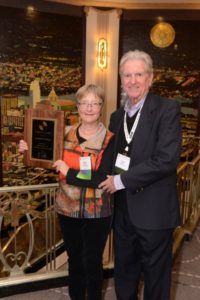
Award recognizes an individual member considered to have contributed the most to the achievement of NALMS’ goal.
Gertrud Nürnberg
Nominated by Gene Welch, Jack Jones, Al Sosiak, Dick Osgood, Shannon Brattebo, and Dennis Cooke
Gertrud has served NALMS in numerous ways. She was on the journal editorial board for 18 years (1996-2014), board member during 1999 to 2002, and has conducted the phosphorus internal loading workshop for 15 years, including this year’s symposium. She has forged an international reputation for describing and quantifying internal loading and assembled data from world lakes, over the past 30 years at least, to develop equations including that process. Also, she increased the understanding of hypolimnetic withdrawal by evaluating data from several lakes, developed the anoxic factor, and produced the most useful set of trophic state criteria, published in Lake and Reservoir Management. Those are highly valuable contributions to the science of lake restoration. Before lakes can be restored or rehabilitated there must be a basic understanding of important processes, and Gertrud is especially good at that.
As an independent researcher and consultant, she is a strong and enthusiastic representative for the science of applied limnology and a frequent contributor at NALMS conferences and Lake and Reservoir Management. Her contributions have greatly strengthened the science of lake restoration and management.
Gertrud is also an outstanding role model for young limnologists and scientists. She always actively listens to presentations by students and young professionals at the NALMS symposia and provides constructive and thought-provoking feedback. Her interactions with fellow NALMS members and symposium participants are always engaging, respectful, and focused on furthering the understanding of lake dynamics.
A specific case in which Gertrud’s expertise guided the restoration effort is as follows:
“A community-based lake restoration society at Pine Lake, Alberta, Canada completed a program of watershed projects and one in-lake treatment project to reduce phosphorus loading to this lake in 1998. Eight in-lake treatment options were evaluated, and the selected option was hypolimnetic withdrawal. This method was first recommended for this lake by Gertrud Nurnberg following an evaluation of conditions in this lake. Following system design and modelling to evaluate the potential water quality impacts, the system was installed by the society in the fall of 1998. Regular water quality monitoring continued during system installation, and all results to 2016 were evaluated during a presentation at the 2016 NALMS symposium by A. Sosiak. This evaluation demonstrated a significant reduction in chlorophyll a following system installation, and reduced incidence of severe nuisance cyanobacterial blooms. Gertrud’s enthusiastic support for this method helped the society at Pine Lake improve conditions in their lake.”
